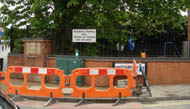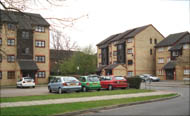Neasden Hospital
Brentfield Road, Neasden, NW10 8EY
Medical dates:
Medical character:
Infectious diseases. Later also ENT, geriatric and orthopaedics
In 1894 Willesden District
Council opened a fever hospital on an isolated 10 acre site in Dog Lane
(the Stonebridge portion of Dog Lane was later renamed Brentfield
Road), nearby the local sewage works.
The Hospital was extended in 1904, when it then had 150 beds.
During WW1 its name was change to Willesden Municipal Hospital.
In 1922 it was debated whether it should be further extended and become a general hospital, but it remained an infectious diseases hospital. By 1922 it had 138 beds.
It was extended once more in the 1930s, when it had 200 beds.
In 1948 it joined the NHS. A newly refurbished theatre block opened in 1949 with 16 beds for tonsillectomy patients.
By 1953 the Hospital had 128 beds for patients with acute infectious diseases, mainly food poisoning (salmonella, typhoid and dysentery), whooping cough, diphtheria and croup. About 60% of its patients were children. Twenty beds were for TB patients, but smallpox patients were not admitted. The number of geriatric beds had been reduced from 52 to 40. There were 12 ENT beds for patients admitted for removal of adenoids and tonsils, but the ENT ward was closed for six weeks because of the polio epidemic. The Hospital lacked an X-ray Department - it had only a mobile unit - and patients were sent to the Central Middlesex Hospital if necessary.
The Hospital became a specialist centre for the treatment of bulbar poliomyelitis, a severe form of the infection which affects the nerve cells in the medulla oblongata, resulting in dysfunction of the swallowing mechanism, respiratory embarrassment and circulatory distress. These patients were usually adult and were more difficult to treat; there was a high morbidity rate.
In 1958 an eye unit was added.
In 1966 the Hospital was involved in a scandal about a memorandum issued by the physician superintendent, Dr W.F. Twining McMath, concerning resuscitation in the event of respiratory failure and cardiac arrest. It stated "The following patients are not to be resuscitated: Very elderly, over 65 years; malignant disease; chronic chest disease; chronic renal disease". The BBC television programme Tomorrow's World disclosed the existence of this memorandum and it was subsequently extensively discussed in the national press and on television.
By 1975 the number of beds had been reduced to 175. In 1978 it became a geriatric hospital.
It closed in 1986 with 83 beds, the nurses being evicted from their Nurses' Home in December of that year.
Present status (April 2008)
The 8 acre site was sold to the Paddington Churches Housing Association to provide 150 fair rent and 60 shared-ownership homes.
The Hospital was extended in 1904, when it then had 150 beds.
During WW1 its name was change to Willesden Municipal Hospital.
In 1922 it was debated whether it should be further extended and become a general hospital, but it remained an infectious diseases hospital. By 1922 it had 138 beds.
It was extended once more in the 1930s, when it had 200 beds.
In 1948 it joined the NHS. A newly refurbished theatre block opened in 1949 with 16 beds for tonsillectomy patients.
By 1953 the Hospital had 128 beds for patients with acute infectious diseases, mainly food poisoning (salmonella, typhoid and dysentery), whooping cough, diphtheria and croup. About 60% of its patients were children. Twenty beds were for TB patients, but smallpox patients were not admitted. The number of geriatric beds had been reduced from 52 to 40. There were 12 ENT beds for patients admitted for removal of adenoids and tonsils, but the ENT ward was closed for six weeks because of the polio epidemic. The Hospital lacked an X-ray Department - it had only a mobile unit - and patients were sent to the Central Middlesex Hospital if necessary.
The Hospital became a specialist centre for the treatment of bulbar poliomyelitis, a severe form of the infection which affects the nerve cells in the medulla oblongata, resulting in dysfunction of the swallowing mechanism, respiratory embarrassment and circulatory distress. These patients were usually adult and were more difficult to treat; there was a high morbidity rate.
In 1958 an eye unit was added.
In 1966 the Hospital was involved in a scandal about a memorandum issued by the physician superintendent, Dr W.F. Twining McMath, concerning resuscitation in the event of respiratory failure and cardiac arrest. It stated "The following patients are not to be resuscitated: Very elderly, over 65 years; malignant disease; chronic chest disease; chronic renal disease". The BBC television programme Tomorrow's World disclosed the existence of this memorandum and it was subsequently extensively discussed in the national press and on television.
By 1975 the number of beds had been reduced to 175. In 1978 it became a geriatric hospital.
It closed in 1986 with 83 beds, the nurses being evicted from their Nurses' Home in December of that year.
Present status (April 2008)
The 8 acre site was sold to the Paddington Churches Housing Association to provide 150 fair rent and 60 shared-ownership homes.

New housing

An old wall, which may be part of the old Hospital site

Kingfisher Way

New housing

New housing

Brentfield Medical Centre
(Author not stated) 1967 Neasden Memorandum on Resuscitation. British Medical Journal 3 (5569), 858-859.
http://hansard.millbanksystems.com
www.brent.gov.uk
www.british-history.ac.uk
www.rcnarchive.rcn.org.uk
Return to home page